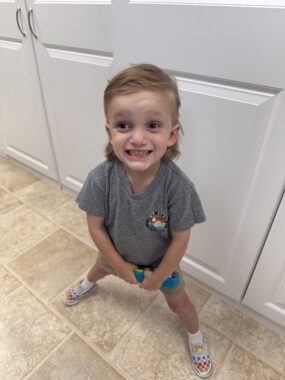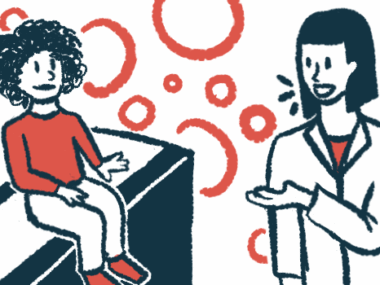My son has his own understanding of his liver disease medications
How my wife and I explain Alagille treatments to our 4-year-old
Written by |

Every time I meet another family raising a child with Alagille syndrome, the topic of medication comes up. I have found that parents and caregivers are curious about what options are out there. Because Alagille syndrome is a multisystem condition that affects everyone in different ways, comparing notes with other families is fascinating. But my main focus is explaining and normalizing medications for my 4-year-old son, Finley.

Finley rocks his brand-new haircut. (Photo by Jay Sandstrom)
Finley has been taking medication since he was in the neonatal intensive care unit, after being born about a month premature. It’s all he’s ever known. As he has grown, my wife, Dani, and I have worked to explain why he needs each treatment in ways he can understand.
One prescription, hydroxyzine, is for his “itchies.” For me, cholestatic pruritus, or the dreaded itch, is the hardest part of raising a child with Alagille. I cannot imagine having an itch that lingers no matter how much you scratch. I am beyond thankful that we’re able to treat this symptom. The antihistamine has been a game changer for Finley.
Next is ursodiol, which Finley will tell you he takes to “make his poop brown.” That is a major oversimplification of the medication, which improves his bile flow, but it’s what Finley understands.
Those two drugs have been the most consistent ones in Finley’s medicine cabinet. The others have been a rotating cast of characters.
Recently, we added back in some old friends, vitamins E and D. Finley was off of them for a few years, but following recent labs, we started him back on them.
Vitamin D — or, as Finley calls it, his “sunshine medicine” — took some getting used to. To say it was a tough reintroduction would be an understatement. The battles were epic; the tears flowed. We figured out that Finley liked looking at baby pictures of himself to calm down, and that it helped for him to take the medication slowly, so we used those methods for a while. After a few months, it became a regular part of his routine, and he now takes the vitamin with ease. Most of the time, he doesn’t even need the visual aids to relax.

Baby Finley drinks formula from a bottle stained by the multivitamin. (Photo by Jay Sandstrom)
Lastly, I want to dedicate some space to the supplement I hope to never see again: the dreaded multivitamin Finley had to take for a few years after his Alagille diagnosis. He hated it. I hated giving it to him. It smelled like batteries and dirt, and with its burnt-orange color, it stained anything it touched. As a baby, Finley spit up frequently and in high volume, so we learned to keep him on old blankets and towels when he took it.
The image of him gagging and spitting up as a tiny 3-month-old is burned into my brain. It was scary and frustrating. I’ll never forget the day some amazing soul online recommended adding the multivitamin to his formula. It worked like a charm. He’d still spit up, but administering the vitamin was no longer a challenge. Though the bottles were all stained permanently orange over time, it was totally worth it to help Finley stomach the supplement. I’m crossing my fingers that we can continue to leave that one in the rearview mirror.
Overall, Finley does a great job taking his medication. He has his own understanding of his liver disease, and we continue to work on explaining things to him.
Note: Liver Disease News is strictly a news and information website about the disease. It does not provide medical advice, diagnosis, or treatment. This content is not intended to be a substitute for professional medical advice, diagnosis, or treatment. Always seek the advice of your physician or other qualified health provider with any questions you may have regarding a medical condition. Never disregard professional medical advice or delay in seeking it because of something you have read on this website. The opinions expressed in this column are not those of Liver Disease News or its parent company, Bionews, and are intended to spark discussion about issues pertaining to liver disease.







Leave a comment
Fill in the required fields to post. Your email address will not be published.